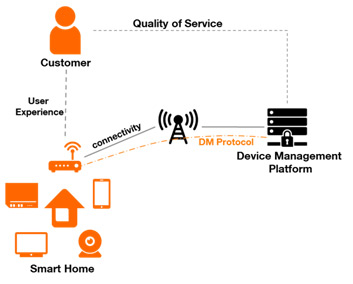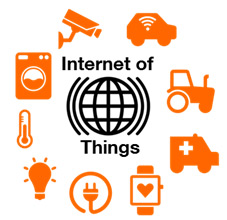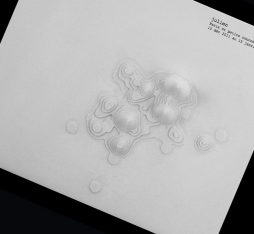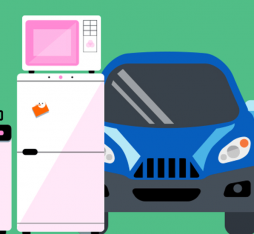Summary
Device Management is a tool enabling telecommunications operators, manufacturers and service providers to make sure that smart objects installed on clients’ premises are working correctly. In our environments, this invisible “masked hero” is becoming more crucial by the day, providing an ecosystem of reliable equipment for the countless services of the IoT, with the smart city, healthcare, agriculture, the smart home, or industry 4.0.
However, the IoT does present challenges to be addressed for operation to be reliable and long-lasting: heterogeneity of devices, diversity of usages, security, confidentiality, and availability. IoT platforms, initially designed to collect data so as to extract information and provide recommendations, are dependent on Device Management. Orange is exploring innovative solutions to treat these problems, for example via a new generation of Device Management platforms capable of taking the context of users and of their devices into account whilst guaranteeing their privacy protection.
Thing’in, the research platform developed by Orange, represents physical things in the form of a graph of avatars describing the characteristics, capabilities and relationships of objects among themselves. It enables different partners to work together to develop smart services based on this unified description, and is the ideal tool for smart and scalable Device Management for all of the smart objects of tomorrow.
Full Article
Have you already wondered why you could not connect to the Internet anymore at home, called a family member for help, were told you to simply reboot (turn on and off) your router provided by your Internet Service Provider, and everything works again for no apparent reason? Well then, you have already experienced the wonders of Device Management, the tool allowing Telecom Operators (Telcos), manufacturers and service providers to ensure that connected devices in the customers’ premises function correctly.
With the ever developing Internet of Things, these connected devices are more present every day in our environments, enabling innumerable services. For instance, Smart Industry relies on these devices for parcel tracking, process optimization; but they can be used in Smart Homes, through video surveillance or lighting control.
As the “masked hero” of connected devices and smart services, Device Management is the backbone for a well-functioning, global connected device ecosystem: the perfect Device Management does not reveal its presence! For this, it can be enriched with context and surroundings data in order to adapt itself to the different lifecycles of constrained, often battery-powered IoT devices, all the while preventing any interference with user services. Within Orange, we explore innovative solutions to handle these issues, and offer a transparent Device Management that ensures the perfect functioning of our users’ services in their day-to-day lives, all the while respecting their privacy.
What is Device Management, and why is it so important?
A device is a unit of hardware with computing capabilities that aims at providing specific services. When it can communicate with other devices, it is called a connected device.
Device Management consists of a set of operations remotely executed on connected devices in a secure environment: provisioning, configuration, firmware updates, and diagnostics.
1. Provisioning is the process involved when the device connects for the first time, providing the necessary credentials, right configuration and firmware version.
2. Configuration refers to the activation and setting of device services, such as Wi-Fi activation on a modem.
3. Software and firmware updates/upgrades are destined to take corrective measures and augment the device with new services.
4. Diagnostics consist in test and monitoring tasks, providing information about the device, such as events and logs, so as to detect problems and potentially trigger repair actions.

Within Device Management (DM), two different technical entities come into play: the DM platform, hosted in the cloud of the operator, and the DM client, installed on the device to manage. The communication between these two entities is based on a dedicated Device Management protocol. It is important to note that it is not possible to manage a device with a specific Device Management platform if the device does not have the corresponding client. It means that a Telco or Service Provider can only manage a selective number of devices in your local network, devices that they often provide themselves: your Telco-provided modem is managed by your Telco, and your smart lights are managed by your connected house service provider. The ultimate goal of Device Management is enhancing device performance and guarantee its well-functioning. Additionally, Device Management aims at limiting physical interventions of technicians, all the while maintaining a level of Quality of Service (QoS) and User Experience.
Device Management is performed remotely, meaning the Device Management platform is outside of your local network. But what is a local network you say?
The Local Area Network (LAN) vs Wide Area Network (WAN)
Your devices at home are not directly connected to the Internet. They are actually connected to your router/modem, through cable or Wi-Fi, and only the modem/router, also called gateway, is connected to the Internet. Thus, your devices belong to your local network (LAN), created by your router, while your router is also part of the wide area network (WAN). The gateway protects devices in the LAN, as it makes them invisible from the WAN. It will simply act as the mandatory relay between a local device, which supports the Internet Protocol (IP), and the rest of the Internet.

However, some devices, such as Bluetooth devices, do not support the Internet Protocol. An additional component, often located in the Internet Service Provider modem/router, will act as a bridge, translating non-IP messages to IP. These messages can then be sent to the WAN in the same manner as for true IP devices.
The Future of the Internet: the Internet of Things
While mostly computers and smartphones were previously connected to the Internet, more and more devices are able to send and receive data nowadays, from smart plugs, lights, sensors to cameras or coffee makers. These devices expand the original Internet network, transitioning to a new paradigm called the Internet of Things (IoT).
The Internet of Things is reshaping the future of many industries through moving forward a digital transformation. Today, IoT mainly impact companies’ processes and human daily activities through multiple vertical sectors such as Smart Cities, Healthcare, Agriculture, and Industry 4.0. IoT devices are the key elements in the creation of new business value.

New Challenges for IoT Device Management
With the proliferation of the Internet of Things, it is crucial to constantly guarantee the well-functioning of the integrated devices, to maintain their security, and to ensure the evolution and maintenance of this ever-growing number of connected devices, all the while anticipating the requirements issued from new devices and services. ABIresearch[1] estimates that the revenue of IoT Device Management will climb to US$20.5 Billion by 2023. However, IoT comes with its lot of challenges that need to be addressed for a reliable and long-term operation:
- device heterogeneity: To this day, any service delivered to the end-user would rely on a limited set of device types. This means that you need to buy the specific devices associated with a service. Consequently, pre-IoT Device Management platforms are not suited for managing the multitude of models brought by this new paradigm;
- security: Due to the volume of devices required in IoT services, IoT devices need to keep a low price point, which may mean that they do not dispose of the same level of features as other connected devices such as modems. New platforms are then required to ensure the integrity of the network, data and devices themselves;
- privacy: Many IoT services rely on sensor data to adapt to the local context. It is imperative to tailor these services so that they respect the privacy of end-users;
- availability: IoT devices often operate with a battery, requiring sleep cycles, i.e. the device only wakes up shortly, at regular intervals or at specific events, and operates on a battery-saving mode the rest of the time. During this sleep cycle, the device may be unavailable, and cannot provide the data necessary for its associated services.
Which platforms today for an IoT Device Management?
Many big companies are investing in Device Management, and propose their own platform’s enabler for IoT. Different approaches have been investigated to handle the new IoT challenges.
To deal with heterogeneity, protocol extensibility is generally not directly integrated within the platform, and is only enabled to answer particular customer needs through specific gateway software components, whether locally hosted on a physical device, or in the cloud.
Privacy remains a big challenge in the IoT world where connected devices publish data about the physical world, and by extension user context. New regulations keep emerging to control these aspects, with in particular the General Data Protection Regulation (GDPR)[2]. Thus, new architectures are required for multi-level data analysis. Hence, user-context data can be processed multiple times, for example in the LAN (using what is called edge computing), then in the WAN. For example, in the case of a secure home service, the raw data of cameras can be analyzed locally, while only alerts are sent to the corresponding application. That way, it is possible to actually anonymize data, and limit privacy concerns. Thus, within IoT, the role of gateways evolves from a simple translation of non-IP messages to IP to ensuring security and privacy for their associated LAN.
Another important challenge for Device Management is the availability of devices. As explained above, with the dynamicity of the IoT environment, some devices, such as battery-powered ones, may be sleeping at the moment when an application would require the data it produces. Thus, a new element was introduced in the cloud, which serves as an intermediate between devices and applications. Thus, the last known state of the device and its related data are stored in the cloud, in what is called a digital representation[3]. This element, always available for requests, promotes a decorrelation between device communications and their related applications. This representation can also store the wanted state for a device, with target configuration and firmware. An IoT Device Management platform can thus leverage this element to plan operations that will get executed when the devices are ready, respecting their own lifecycles. Thus, security patches are applied as soon as devices wake up, improving the overall security of the system.
Moreover, Device Management platforms must adapt to the new volume of connected devices. It is not possible for a Device Management operator to program operations manually each time a new device appears. To that end, Campaign management tools allow to define operations for large numbers of devices using rules. It is then possible to dynamically enroll devices based on their reported state, which triggers automatic provisioning or firmware upgrade operations. For instance, it is possible to target only devices with a specific firmware, or a specific type.
Finally, the execution of these massive campaigns needs to be controlled. Rollout tools will trigger operations on devices following a cautious strategy: it would be unwise to upgrade every device at the same time if that operation should introduce problems, such as crashes or disconnections. Thus, the targeted device population is divided in sub-groups, whose size may increase as the operation proves to be successful in the earlier test groups. On the contrary, if a problem emerges in the first groups, the whole campaign may be stopped and flagged for support teams.
Combining all these tools, it is becoming easier and easier for an end-user to just connect a newly-bought device to have it work right away, after the Device Management platform automatically detects it, upgrades it, and configures it dynamically, and immediately.
Which solutions tomorrow: Device Management in the Future
Industrial IoT platforms are focused on Business-to-Business opportunities, on verticals such as Smart Industry, City or Building. However, common platform services do not consider the Business-to-Customer market. Devices are tailored to meet specific business requirements, with a highly platform-dependent integration, which precludes the transition to standard devices and protocols. In this context, the Web of Thing is introduced to enable horizontal semantic interoperability of heterogeneous physical and virtual entities referred as “things”. Thing’in[4] is a research platform that represents the physical objects into a graph of avatars describing the objects characteristics, capabilities and relations. It allows different partners, including telecom operators, manufacturers and object owners, to collaborate for the development of smart services.
Smart Device Management
Imagine that you are watching your favorite show on your smart TV and, suddenly, an alert pops up, and the TV becomes unusable. Indeed, it just launched a firmware upgrade process, and you need to wait forever for it to reboot! Who would actually want this to happen?
How about a personalized device management service to prevent these unpleasant situations? Relying on Artificial Intelligence (AI) tools, it is possible to leverage data generated by connected objects to predict the appropriate moment to launch these operations without disrupting the experience of end-users. The data collection and prediction process may be locally hosted (in the LAN) in order to protect customer privacy. The predictions concerning the object state may be stored in Thing’in and shared with the Device Management platform to choose the right time for launching the reboot/Firmware update operation on the object.
With the rapid expansion of the IoT, connected objects are becoming more and more interdependent to ensure connectivity and exchange data. These objects are managed by multi-actor Device Management operators (Telco, manufacturer, service provider, etc.) through isolated Device Management platforms. These interdependencies are challenging for the smooth running of Device Management. Indeed, each isolated platform can trigger operations that render an object temporary unavailable, in particular through a reboot. For example, let us consider a camera managed by its manufacturer which is also connected to a Telco-managed modem/gateway. We may then encounter the following situation: the camera is downloading its new firmware, while the gateway suddenly reboots. Thus, the camera temporary loses its connectivity, leading to a corrupted firmware download, and fails its update. Thus, new platforms such as Thing’in can be used to represent these objects dependencies, as well as describe the available features offered by IoT Device Management platforms, and the means to trigger them. Based on this semantic description, intelligent services may be developed to coordinate and orchestrate the different Device Management platforms to ensure the smooth execution of their goals, as well as providing better user experience.
Security
The multiplication of the number of devices increases the potential reward of malicious actions. This aspect justifies for the specification and development of pro-active Device Management platforms, dynamically detecting and limiting the impact of vulnerabilities through dynamic reconfigurations, i.e. temporary quarantines, continuous diagnostics; and swift firmware upgrades. AI technologies can also be applied to this context, defining normal behaviors for devices, and sending generic alerts when they start to act in an unknown manner. By centralizing these generic alerts, it becomes possible to detect new attacks or dysfunctions in real-time, so as to act swiftly and efficiently.
Conclusion
IoT platforms, initially conceived to collect data in real-time to extract insights and provide recommendations, are dependent on Device Management, essential feature in order to guarantee the well-functioning of devices and their associated services. As devices get more integrated in our everyday lives, new challenges occur, that may deteriorate our Quality of Experience as users. At Orange, we strive for a new generation of Device Management platforms able to consider the context of the users and their devices, all the while ensuring privacy.








